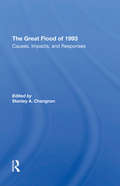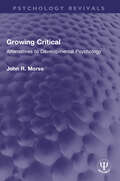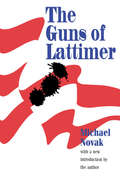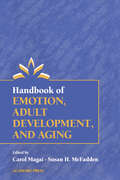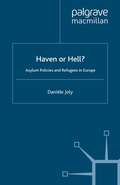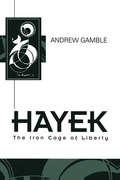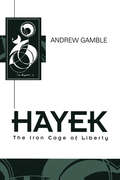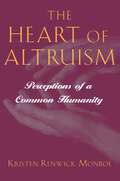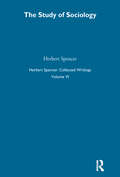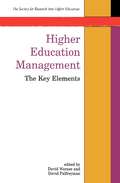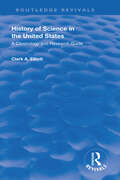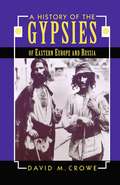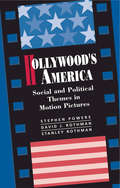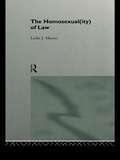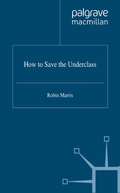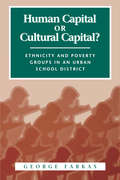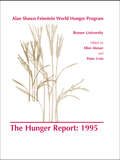- Table View
- List View
The Great Flood Of 1993: Causes, Impacts, And Responses
by Stanley ChangnonThe flood that affected a third of the United States during the summer of 1993 was the nation's worst, ranking as a once-in-300-years event. It severely tested national, state, and local systems for managing natural resources and for handling emergencies, illuminating both the strengths and weaknesses in existing methods of preparing for and dealing with massive prolonged flooding. Through detailed case studies, this volume diagnoses the social and economic impacts of the disaster, assessing how resource managers, flood forecasters, public institutions, the private sector, and millions of volunteers responded to it. The first comprehensive evaluation of the 1993 flood, this book examines the way in which floods are forecast and monitored, the effectiveness of existing recovery processes, and how the nation manages its floodplains. The volume concludes with recommendations for the future, in hope of better preparing the country for the next flood or other comparable disaster.
The Great Flood Of 1993: Causes, Impacts, And Responses
by Stanley ChangnonThe flood that affected a third of the United States during the summer of 1993 was the nation's worst, ranking as a once-in-300-years event. It severely tested national, state, and local systems for managing natural resources and for handling emergencies, illuminating both the strengths and weaknesses in existing methods of preparing for and dealing with massive prolonged flooding. Through detailed case studies, this volume diagnoses the social and economic impacts of the disaster, assessing how resource managers, flood forecasters, public institutions, the private sector, and millions of volunteers responded to it. The first comprehensive evaluation of the 1993 flood, this book examines the way in which floods are forecast and monitored, the effectiveness of existing recovery processes, and how the nation manages its floodplains. The volume concludes with recommendations for the future, in hope of better preparing the country for the next flood or other comparable disaster.
Growing Critical: Alternatives to Developmental Psychology (Psychology Revivals)
by John R. MorssOriginally published in 1996, and now with a new preface, Growing Critical is an introduction to critical psychology, focusing on development. It takes a fresh look at infancy, childhood and adulthood and makes the startling claim that ‘development’ does not exist. John R. Morss guides the reader from the early critical movements of the 1970s which gave rise to the ‘social construction of development’ through the wide range of more recent approaches. He looks in turn at Vygotsky’s ‘social context of development’, Harré’s ‘social constructionism’, Marxist critique of developmental psychology, psychoanalytic interpretations of development, and finally post-structuralist approaches following Foucault and Derrida. He surveys the range of alternative positions in the critical psychology of development and evaluates the achievements of Newman and Holzman, Broughton, Tolman, Walkerdine and others. Marxism, psychoanalysis and post-structuralism – as well as such movements as feminism – challenge our understanding of human development. Morss looks beyond the laboratory to Marx and Freud, to Lacan and Foucault. What sets Growing Critical apart from orthodox psychology is the seriousness with which he has thought through the implications of these challenges. Contemporary and ‘reader-friendly’, Growing Critical will be of value to both undergraduate and advanced students, as well as to anyone interested in human development, in psychology, sociology or education.
Growing Critical: Alternatives to Developmental Psychology (Psychology Revivals)
by John R. MorssOriginally published in 1996, and now with a new preface, Growing Critical is an introduction to critical psychology, focusing on development. It takes a fresh look at infancy, childhood and adulthood and makes the startling claim that ‘development’ does not exist. John R. Morss guides the reader from the early critical movements of the 1970s which gave rise to the ‘social construction of development’ through the wide range of more recent approaches. He looks in turn at Vygotsky’s ‘social context of development’, Harré’s ‘social constructionism’, Marxist critique of developmental psychology, psychoanalytic interpretations of development, and finally post-structuralist approaches following Foucault and Derrida. He surveys the range of alternative positions in the critical psychology of development and evaluates the achievements of Newman and Holzman, Broughton, Tolman, Walkerdine and others. Marxism, psychoanalysis and post-structuralism – as well as such movements as feminism – challenge our understanding of human development. Morss looks beyond the laboratory to Marx and Freud, to Lacan and Foucault. What sets Growing Critical apart from orthodox psychology is the seriousness with which he has thought through the implications of these challenges. Contemporary and ‘reader-friendly’, Growing Critical will be of value to both undergraduate and advanced students, as well as to anyone interested in human development, in psychology, sociology or education.
The Guns of Lattimer
by Michael NovakOn September 10, 1897, in the hamlet of Lattimer mines, Pennsylvania, an armed posse took aim and fired into a crowd of oncoming mine workers, who were marching in their corner of the coal-mining region to call their fellow miners out on strike. The marchers Poles, Slovaks, Hungarians, most of whom could not yet speak English were themselves armed only with an American flag and a timid, budding confidence in their new found rights as free men in their newly adopted country. The mine operators took another view of these rights and of the strange, alien men who claimed them. When the posse was done firing, nineteen of the demonstrators were dead and thirty-nine were seriously wounded. Some six months later a jury of their peers was to exonerate the deputies of any wrong-doing.This long-forgotten incident is here movingly retold by Michael Novak, himself the son of Slovak immigrants and one of our most gifted writers and social observers. In his hands, the so-called "Lattimer Massacre" becomes not only a powerful story in its own right (and an invaluable key to the history of the growth of the united mine Workers), but an allegory of that peculiarly American experience undergone over and over again throughout the land, and down to this very day; the experience of new immigrants, still miserable with poverty and bewilderment and suffering the trauma of culture shock, being confronted by the hostility and blind contempt of the "real" Americans.In Michael Novak's uniquely vivid account, the incident at Lattimer is seen as a tragedy brought on not so much by inhumanity as by the profound failure of majority WASP society to understand the needs and responses of "foreigners." The Guns of Lattimer is a gripping book that tells Americans, old and new, a great deal about themselves and the society they live in.
The Guns of Lattimer
by Michael NovakOn September 10, 1897, in the hamlet of Lattimer mines, Pennsylvania, an armed posse took aim and fired into a crowd of oncoming mine workers, who were marching in their corner of the coal-mining region to call their fellow miners out on strike. The marchers Poles, Slovaks, Hungarians, most of whom could not yet speak English were themselves armed only with an American flag and a timid, budding confidence in their new found rights as free men in their newly adopted country. The mine operators took another view of these rights and of the strange, alien men who claimed them. When the posse was done firing, nineteen of the demonstrators were dead and thirty-nine were seriously wounded. Some six months later a jury of their peers was to exonerate the deputies of any wrong-doing.This long-forgotten incident is here movingly retold by Michael Novak, himself the son of Slovak immigrants and one of our most gifted writers and social observers. In his hands, the so-called "Lattimer Massacre" becomes not only a powerful story in its own right (and an invaluable key to the history of the growth of the united mine Workers), but an allegory of that peculiarly American experience undergone over and over again throughout the land, and down to this very day; the experience of new immigrants, still miserable with poverty and bewilderment and suffering the trauma of culture shock, being confronted by the hostility and blind contempt of the "real" Americans.In Michael Novak's uniquely vivid account, the incident at Lattimer is seen as a tragedy brought on not so much by inhumanity as by the profound failure of majority WASP society to understand the needs and responses of "foreigners." The Guns of Lattimer is a gripping book that tells Americans, old and new, a great deal about themselves and the society they live in.
Handbook of Emotion, Adult Development, and Aging
by Carol Magai Susan H. McFaddenThe field of emotions research has recently seen an unexpected period of growth and expansion, both in traditional psychological literature and in gerontology. The Handbook of Emotion, Adult Development, and Aging provides a broad overview and summary of where this field stands today, specifically with reference to life course issues and aging. Written by a distinguished group of contributing authors, the text is grounded in a life span developmental framework, while advancing a multidimensional view of emotion and its development and incorporating quantitative and qualitative research findings.The book is divided into five parts. Part One discusses five major theoretical perspectives including biological, discrete emotions, ethological, humanistic, and psychosocial. Part Two on affect and cognition discusses the role of emotion in memory, problem solving, and internal perceptions of self and gender. Part Three on emotion and relationships expands on the role of emotion in sibling and parent/child relationships, as well as relationships between friends and romantic partners, and the emotional reaction to interpersonal loss across the life span. Part Four on stress, health, and psychological well-being treats issues of stress and coping, religion, personality, and quality of life. The final part on continuity and change in emotion patterns and personality discusses emotion and emotionality throughout the life span.An ideal reference source for professionals across a wide range of disciplines, the text summarizes recent important developments in this fast growing area of psychology and proposes many new directions for future research.Provides a biopsychological view on emotion in adulthood from a life span contextPresents the new perspective on emotion in older adults actively engaged in emotion self-regulationDescribes the intimate connection between emotion and the structure of personalityDemonstrates a new perspective on what emotion is, its importance across the life span, its connections with cognition, its role in interpersonal relation, and the way it influences both stability and change in adulthoodIllustrates the interpersonal nature of emotionProvides theoretically based, leading edge research from international authorsFive areas of coverage include: Theoretical perspectivesAffect and cognitionEmotion and relationshipsStress, health, and psychological well-beingContinuity and change in emotion patterns and personality Coverage includes: Five major theoretical perspectives, including biological, discrete emotions, ethological, humanistic, and psychosocialThe role of emotion in memory, problem-solving, and internal perceptions of self and genderThe role of emotion in sibling and parent/child relationships, relationships between friends and romantic partners, and the emotional reaction to interpersonal loss across the lifespanIssues of stress and coping, religion, personality, and quality of lifeEmotion and emotionality throughout the lifespan
Haven or Hell?: Asylum Policies and Refugees in Europe (Migration, Minorities and Citizenship)
by D. JolyThis book brings together in a systematic manner three discrete areas of interest pertaining to refugees. Asylum is explored through studies on the evolution of legal instruments in Europe, the harmonisation process of European policies, and the broader spectrum of factors underpinning decisions on asylum. Reception and settlement of refugees are analysed through a comparative study of national programmes in France and Britain and in addition a survey of local authority policies. A typology for refugees is developed and tested by a comparison between Chilean and Vietnamese associations in France and Britain.
Hayek: The Iron Cage of Liberty (Key Contemporary Thinkers)
by Andrew GambleHayek has been one of the key liberal thinkers of the twentieth century. He has also been much misunderstood. His work has crossed disciplines - economics, philosophy and political science - and national boundaries. He was an early critic of Keynes, and became famous in the 1940s for his warnings that the advance of collectivism in western democracies was the road to serfdom. He was a key figure in the post-war revival of free market liberalism and achieved renewed notoriety and some political influence in the 1970s and 1980s as one of the chief intellectual inspirations for the New Right in Britain and the United States. This book traces Hayek's intellectual formation in Austrian economics and English liberalism. It analyzes the main themes of his thought such as the idea of a market order, the nature of knowledge, the limits of government, and his critiques of socialism and conservatism, and assesses the originality and internal coherence of his account of liberalism and modernity as well as his interventions in policy debates. It argues that Hayek the social scientist has to be disentangled from Hayek the ideologue in order to appreciate the importance and implications of some of his insights into the nature of modern societies. As a critical guide to one of the most influential thinkers of our times, this book is an indispensable source. It will be of interest to students in politics, economics and philosophy, as well as to all those interested in a comprehensive introduction to one of the most controversial thinkers of the twentieth century.
Hayek: The Iron Cage of Liberty (Key Contemporary Thinkers)
by Andrew GambleHayek has been one of the key liberal thinkers of the twentieth century. He has also been much misunderstood. His work has crossed disciplines - economics, philosophy and political science - and national boundaries. He was an early critic of Keynes, and became famous in the 1940s for his warnings that the advance of collectivism in western democracies was the road to serfdom. He was a key figure in the post-war revival of free market liberalism and achieved renewed notoriety and some political influence in the 1970s and 1980s as one of the chief intellectual inspirations for the New Right in Britain and the United States. This book traces Hayek's intellectual formation in Austrian economics and English liberalism. It analyzes the main themes of his thought such as the idea of a market order, the nature of knowledge, the limits of government, and his critiques of socialism and conservatism, and assesses the originality and internal coherence of his account of liberalism and modernity as well as his interventions in policy debates. It argues that Hayek the social scientist has to be disentangled from Hayek the ideologue in order to appreciate the importance and implications of some of his insights into the nature of modern societies. As a critical guide to one of the most influential thinkers of our times, this book is an indispensable source. It will be of interest to students in politics, economics and philosophy, as well as to all those interested in a comprehensive introduction to one of the most controversial thinkers of the twentieth century.
The Heart of Altruism: Perceptions of a Common Humanity
by Kristen Renwick MonroeIs all human behavior based on self-interest? Many social and biological theories would argue so, but such a perspective does not explain the many truly heroic acts committed by people willing to risk their lives to help others. In The Heart of Altruism, Kristen Renwick Monroe boldly lays the groundwork for a social theory receptive to altruism by examining the experiences described by altruists themselves: from Otto, a German businessman who rescued over a hundred Jews in Nazi Germany, to Lucille, a newspaper poetry editor, who, armed with her cane, saved a young girl who was being raped. Monroe's honest and moving interviews with these little-known heroes enable her to explore the causes of altruism and the differences between altruists and other people. By delineating an overarching perspective of humanity shared by altruists, Monroe demonstrates how social theories may begin to account for altruism and debunks the notions of scientific inevitability that stem from an overemphasis on self-interest. As Monroe has discovered, the financial and religious backgrounds of altruists vary greatly--as do their views on issues such as welfare, civil rights, and morality. Altruists do, however, share a certain way of looking at the world: where the rest of us see a stranger, altruists see a fellow human being. It is this perspective that many social theories overlook. Monroe restores altruism to a general theory of ethical political behavior. She argues that to understand what makes one person act out of concern for others and not the self, we need to ask how that individual's perspective sets the range of options he or she finds available.
Herbert Spencer: Volume VI The Study of Sociology
by Herbert SpencerHerbert Spencer (1820-1903) was regarded by the Victorians as the foremost philosopher of the age, the prophet of evolution at a time when the idea had gripped the popular imagination. Until recently Spencer's posthumous reputation rested almost excusively on his social and political thought, which has itself frequently been subject to serious misrepresentation. But historians of ideas now recognise that an acquaintance with Spencer's thought is essential for the proper understanding of many aspects of Victorian intellectual life, and the present selection is designed to answer this need. It provides a cross-section of Spencer's works from his more popular and approachable essays to a number of the volumes of the Synthetic Philosophy itself. Volume VI The Study of Sociology.
Herbert Spencer: Volume VI The Study of Sociology (Works By And About Herbert Spencer Ser.)
by Herbert SpencerHerbert Spencer (1820-1903) was regarded by the Victorians as the foremost philosopher of the age, the prophet of evolution at a time when the idea had gripped the popular imagination. Until recently Spencer's posthumous reputation rested almost excusively on his social and political thought, which has itself frequently been subject to serious misrepresentation. But historians of ideas now recognise that an acquaintance with Spencer's thought is essential for the proper understanding of many aspects of Victorian intellectual life, and the present selection is designed to answer this need. It provides a cross-section of Spencer's works from his more popular and approachable essays to a number of the volumes of the Synthetic Philosophy itself. Volume VI The Study of Sociology.
Higher Education Management (UK Higher Education OUP Humanities & Social Sciences Higher Education OUP)
by David Warner David PalfreymanMany higher education institutions are like small towns, meeting the needs of their members by providing not only specialist teaching and research activities but also residential accommodation, catering, telecommunications, counselling, sports facilities and so on. The management of these institutions is very complex, requiring both generalist and specialist knowledge and skills; and the move to formal strategic planning means that it is no longer acceptable for higher education managers to be aware only of their own relatively narrow areas of expertise. All new managers would benefit from an holistic perspective on managing a whole institution. As such individuals are promoted, such 'helicopter vision' becomes a precondition of their and their institution's success. Higher Education Management provides:the first comprehensive account of non-academic higher education management.contributions from distinguished practitioners of university management.a key resource for all aspiring, trainee and practising managers in higher education.
History Of Science In The U.S.
by Clark A. ElliottFirst published in 1996. The intention of this volume is two-fold: first, to give a chronologically arranged overview of selected data on the history of science in the United States, and second, to orient the reader to the substantial reference literature and research sources as guidance to further study of the topic. The subject areas that are covered include astronomy, biology, chemistry, geology, mathematics, physics, and their related disciplines; areas such as anthropology and psychology are covered to a lesser extent. Science is the central focus, but the content of the work recognizes that the boundaries between subjects or activities are not absolute and certainly not when coverage spans several centuries.
History Of Science In The U.S.
by Clark A. ElliottFirst published in 1996. The intention of this volume is two-fold: first, to give a chronologically arranged overview of selected data on the history of science in the United States, and second, to orient the reader to the substantial reference literature and research sources as guidance to further study of the topic. The subject areas that are covered include astronomy, biology, chemistry, geology, mathematics, physics, and their related disciplines; areas such as anthropology and psychology are covered to a lesser extent. Science is the central focus, but the content of the work recognizes that the boundaries between subjects or activities are not absolute and certainly not when coverage spans several centuries.
A History of the Gypsies of Eastern Europe and Russia
by D. CroweDavid Crowe draws from previously untapped East European, Russian, and traditional sources to explore the life, history, and culture of the Gypsies, or Roma, from their entrance into the region in the Middle Ages until the present.
Hollywood's America: Social And Political Themes In Motion Pictures
by Stephen P PowersAmerican motion pictures still dominate the world market with an impact that is difficult to measure. Their role in American culture has been a powerful one since the 1930s and is a hallmark of our culture today. Though much has been written about the film industry, there has been very little systematic attention paid to the ideology of its creative elite. How does the outlook of that elite impact on the portrayals of America that appear on the screen? How do their views interact with the demands of the market and the structure of the industry to determine the product that is seen by mass audiences? Hollywood's America is a marvellously rich and careful discussion of these questions. It combines a meticulous systematic content analysis of fifty years of top-grossing films with a history of the changing structure of the industry. To that mixture it adds an in-depth survey of Hollywood's creative elite, comparing them to other leadership groups. The result is a balanced discussion of unique breadth and depth on a subject of national importance.Placing the film industry in the context of American society as a whole, the authors point out that Hollywood's creative leadership impacts the larger society even as it is influenced by that society. The creators of films cannot remove themselves too far from the values of the audiences that they serve. However, the fact that films are made by a relatively small number of people, who, as the authors demonstrate, tend to share a common outlook, means that, over time, motion pictures have had an undeniable impact on the beliefs, lifestyles, and action of Americans.This study contributes to the debate over the role and influence of those who create and distribute the products of mass culture in the United States.The book also contains a devastating critique of the poststructuralist theories that currently dominate academic film criticism, demonstrating how they fail in their attempt to explain the political significance of motion pictures.
The Homosexual(ity) of law
by Leslie MoranFirst published in 1996. Routledge is an imprint of Taylor & Francis, an informa company.
The Homosexual(ity) of law
by Leslie MoranFirst published in 1996. Routledge is an imprint of Taylor & Francis, an informa company.
How to Save the Underclass
by R. MarrisThe outstanding moral problem of our time is the emergence of an underclass, provoking both pity and an angry political backlash. Robin Marris finds that a slowdown in growth is the root cause, leading to a collapse of the labour market for unskilled men in particular. Fashionable solutions such as lower wages or welfare reform benefit those already well-off, and exacerbate growing income inequality. He employs statistical, sociological and psychological analysis and new developments in 'brain science' to show how the creation of an open society with increased equality of opportunity risks creating an unnecessarily excessive meritocracy. The solution is restoring national and international priority to the objective of growth. If this fails, damage limitation is essential. We must learn to live with the welfare state.
Human Capital or Cultural Capital?: Ethnicity and Poverty Groups in an Urban School District (Social Institutions And Social Change Ser.)
by George FarkasThis study seeks to reorient our understanding of the early educational determinants of social stratification outcomes. It focuses on the process and consequences of unequal cognitive skill attainment for ethnic and poverty groups within our nation's cities. It draws, theoretically, on the notion that experiences at home and school create a feedback loop by which the ""cultural capital"" of the students (their toolkit of skills, habits, and styles with which they construct strategies of action) evolves over time and largely determines differential success in mastering the teacher-assigned homework.
Human Capital or Cultural Capital?: Ethnicity and Poverty Groups in an Urban School District
by George FarkasThis study seeks to reorient our understanding of the early educational determinants of social stratification outcomes. It focuses on the process and consequences of unequal cognitive skill attainment for ethnic and poverty groups within our nation's cities. It draws, theoretically, on the notion that experiences at home and school create a feedback loop by which the ""cultural capital"" of the students (their toolkit of skills, habits, and styles with which they construct strategies of action) evolves over time and largely determines differential success in mastering the teacher-assigned homework.
The Hunger Report 1995: The Alan Shawn Feinstein World Hunger Program, Brown University, Providence, Rhode Island
by E. Messer P. UvinThe Hunger Report 1995 highlights progress during the past five years on the problems of food shortage, poverty-related hunger, maternal-child nutrition and health, and micronutrient malnutrition. It is constructed from papers and discussions presented at the five-year-follow-up to the Bellagio Declaration, 'Overcoming Hunger in the 1990s' (1989). Individual essays by hunger researchers, monitors, and policy makers assess advances in achieving the Bellagio goals, which are: 1) to end famine deaths, especially by moving food into zones of armed conflict; 2) to end hunger in half the world's poorest households; 3) to eliminate at least half the hunger of women and children by expanding maternal-child health coverage; and 4) to eliminate vitamin A and iodine deficiencies as public health problems.
The Hunger Report 1995: The Alan Shawn Feinstein World Hunger Program, Brown University, Providence, Rhode Island
by Ellen Messer Peter UvinThe Hunger Report 1995 highlights progress during the past five years on the problems of food shortage, poverty-related hunger, maternal-child nutrition and health, and micronutrient malnutrition. It is constructed from papers and discussions presented at the five-year-follow-up to the Bellagio Declaration, 'Overcoming Hunger in the 1990s' (1989). Individual essays by hunger researchers, monitors, and policy makers assess advances in achieving the Bellagio goals, which are: 1) to end famine deaths, especially by moving food into zones of armed conflict; 2) to end hunger in half the world's poorest households; 3) to eliminate at least half the hunger of women and children by expanding maternal-child health coverage; and 4) to eliminate vitamin A and iodine deficiencies as public health problems.
